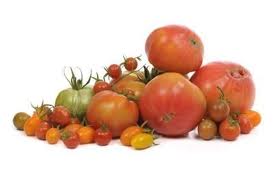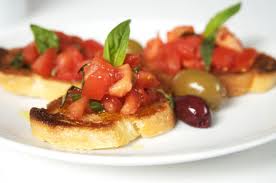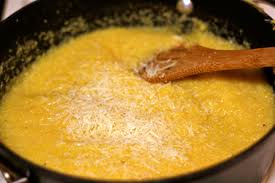By now most of us are, as the saying goes, “tomatoed-out.” In the dark days of winter we dream of fresh, succulent vine-ripened tomatoes. By late August, we’ve just about had our fill. I mean, how many tomato salads or stuffed tomatoes can you have? Well, kiddies, the season will last until October. And, yes, there are still many innovative ways to use this vegetable. Below are given some ingenious ways to use tomatoes. So, in the middle of a frosty February, you can again begin to dream of the fresh juicy crop come June .
RAW TOMATO SAUCE
That’s right, a raw sauce where the tomatoes don’t have to be cooked. Simple: In a bowl, combine 1 pound chopped tomatoes or 1 pint cherry tomatoes, halved; 1/2 cup diced mozzarella cheese; 1/3 cup chopped black olives; 1/4 cup olive oil; 1 teaspoon capers; 1 tablespoon red wine vinegar and 2 garlic cloves, minced. Stir in 1/4 cup fresh chopped basil, 1 teaspoon oregano, salt and pepper to taste. Let the bowl stand for 1/2 hour to allow the flavors to combine. Toss with you favorite hot pasta. 4 servings.
TOMATO WITH BASIL AND MOZZARELLA
The all time favorite, and the easiest thing to prepare: Wash and slice off the tops and bottoms of 1 pound tomatoes, and cut the tomatoes into about 3 slices each. Slice 1/2 pound mozzarella very thinly; wash and dry 10-12 large basil leaves (more if the leaves are small). On a salad plate, arrange the mozzarella and basil on the tomato slices, drizzle with olive oil, and sprinkle with some oregano and pepper. 4-3 servings.
TOMATO GRATIN
A fancy-fied tomato dish to impress your guests: Preheat oven to 500 degrees F. Cut 2 large beefsteak tomatoes into 1/2-inch slices. Arrange the slices, slightly overlapping, in an oiled 9-inch gratin dish or shallow casserole. Sprinkle with salt and pepper to taste, 2 tablespoons finely chopped basil, and 1 teaspoon oregano. Cook 2 garlic cloves, peeled and minced, in a small pan or skillet over moderate heat, stirring until fragrant, about 1 minute. Remove from heat and stir in 1 cup fresh bread crumbs, 1/3 cup grated Parmesan cheese, and salt and pepper to taste. Sprinkle over the tomatoes, and bake in the middle of oven until bread crumbs are golden, about 15 minutes. 4 servings.
TOMATO-FETA PITA SANDWICHES
In a large bowl, combine 1/4 cup olive oil and 1 tablespoon red wine vinegar. Add 1 teaspoon oregano, and salt and pepper to taste; 1 pint cherry tomatoes, halved; 1 medium cucumber, peeled, seeded and diced; 1 medium green bell pepper, chopped; 1/3 cup black olives, halved; 1 small red onion, chopped; and 1/2 cup fresh chopped parsley. Mix together, then stir in 1 cup crumbled feta cheese. Take 4 (8-inch) diameter pita bread, cut in halve and stuff with the tomato mixture. 4 servings.
HOMEMADE KETCHUP
That’s right, homemade ketchup. Believe me, much better than the stuff you get at the grocers, and much healthier. Store bought ketchup is all processed sugar and salt. Ca-ca. And the homemade brand is so easy to make: In a food processor, puree and blend 1/3 cup water; 3 small tomatoes, chopped; 2 tablespoons white vinegar; 1/4 teaspoon ground cloves; 1/4 teaspoon pepper; 1/3 cup honey; 1 tablespoon maple syrup, and 1 tablespoon cornstarch. That’s it. You’ll never use the store-bought stuff again.


















